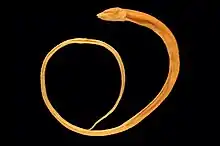Blind cave eel
The blind cave eel (Ophisternon candidum) is a species of fish in the family Synbranchidae. It is endemic to subterranean waters in the coastal Pilbara region and Barrow Island (Western Australia).[3] Like other cavefish such as Milyeringa (the only other vertebrates restricted to subterranean waters in Australia), the blind cave eel is entirely blind and lacks pigmentation.[2] It is listed as vulnerable under the Australian Environment Protection and Biodiversity Conservation Act 1999. Reaching a length of 40 cm (16 in), it is the longest known cavefish.[4]
| Blind cave eel | |
|---|---|
 | |
| Scientific classification | |
| Kingdom: | Animalia |
| Phylum: | Chordata |
| Class: | Actinopterygii |
| Order: | Synbranchiformes |
| Family: | Synbranchidae |
| Genus: | Ophisternon |
| Species: | O. candidum |
| Binomial name | |
| Ophisternon candidum (Mees, 1962) | |
| Synonyms[2] | |
|
Anommatophasma candidum Mees, 1962 | |
Diet
Due to their habitat, little is known about the biology of this species. They feed opportunistically upon small animals such as crustaceans (shrimp and woodlice) and insects (adults and larvae), including both aquatic species and terrestrial species that have fallen into the water.[5]
References
- Moore, G. (2019). "Ophisternon candidum". The IUCN Red List of Threatened Species. IUCN. 2019: e.T15386A123378485.
- Froese, Rainer and Pauly, Daniel, eds. (2017). "Ophisternon candidum" in FishBase. May 2017 version.
- Moore, G.I., Humphreys, W.F. and Foster, R. (2018). New populations of the rare subterranean Blind Cave Eel Ophisternon candidum (Synbranchidae) reveal recent historical connections throughout north-western Australia. Marine and Freshwater Research. 69: 1517–1524. doi:10.1071/MF18006.
- Department of the Environment, Water, Heritage and the Arts (2008). Ophisternon candidum in Species Profile and Threats Database, Department of the Environment, Water, Heritage and the Arts, Canberra. Ophisternon candidum — Blind Cave Eel Downloaded 3 January 2008.
- Humphreys & Freinberg (1995). "Food of the blind cave fishes of northwestern Australia". Records of the Western Australian Museum. 17: 29–33.
Further reading
- Moore, G.I, W.F. Humphreys and R. Foster (2018). New populations of the rare subterranean blind cave eel Ophisternon candidum (Synbranchidae) reveal recent historical connections throughout north-western Australia. Marine and Freshwater Research 69(10): 1517–1524. doi:10.1071/MF18006.
- Moore, G.I. (2018). New morphological data and live photographs of the rare subterranean Blind Cave Eel Ophisternon candidum (Synbranchidae) from north-western Australia. Ichthyological Research. 66: 160–165. doi:10.1007/s10228-018-0647-2.
- White, N.E., Guzik, M.T., Austin, A.D., Moore, G.I., Humphreys, W.F., Alexander, J. and Bunce, M. (2020). Detection of the rare Australian endemic blind cave eel (Ophisternon candidum) with environmental DNA: implications for threatened species management in subterranean environments. Hydrobiologia 847: 3201–3211. doi:10.1007/s10750-020-04304-z.
